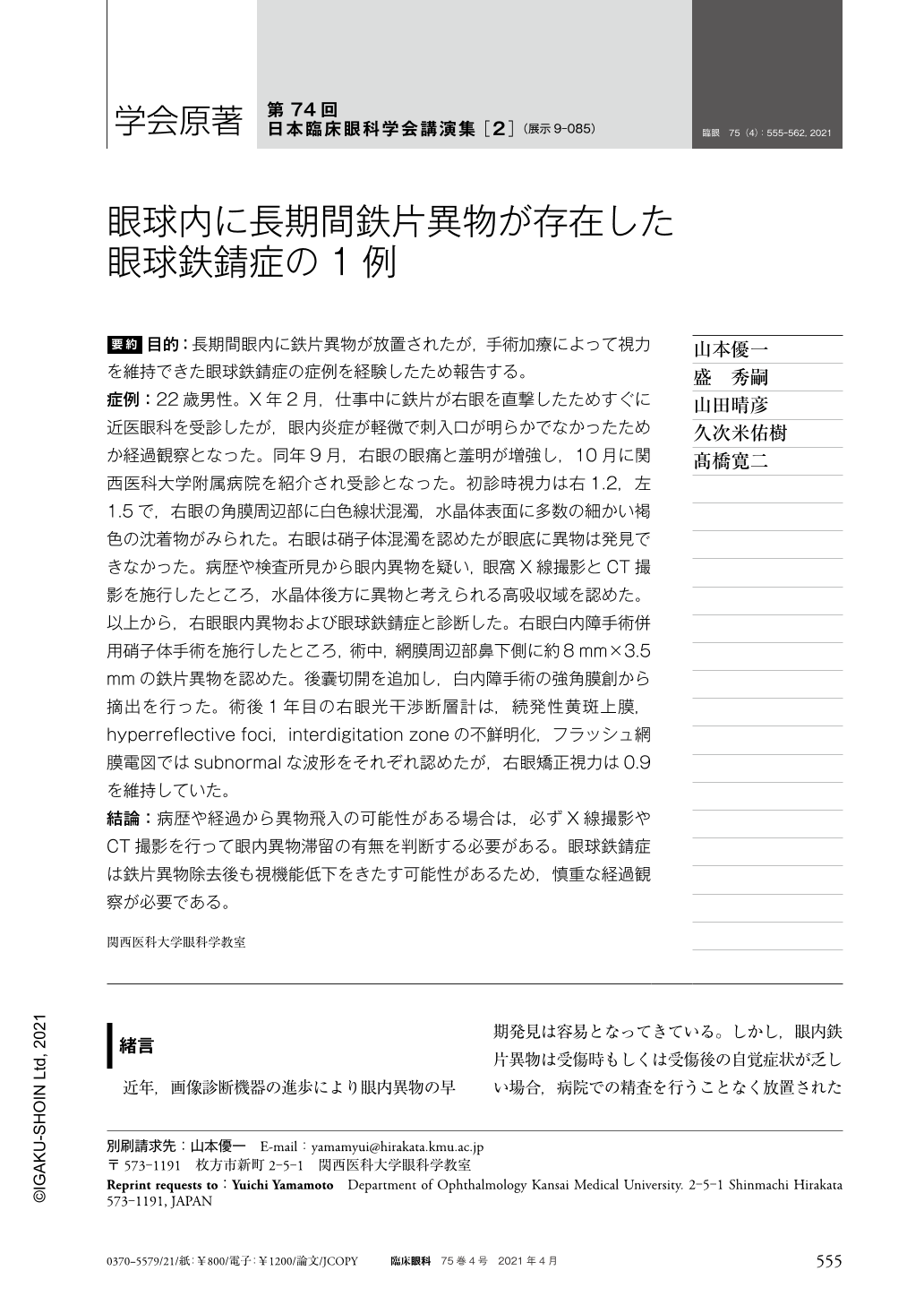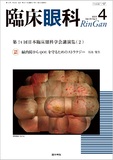Japanese
English
- 有料閲覧
- Abstract 文献概要
- 1ページ目 Look Inside
- 参考文献 Reference
要約 目的:長期間眼内に鉄片異物が放置されたが,手術加療によって視力を維持できた眼球鉄錆症の症例を経験したため報告する。
症例:22歳男性。X年2月,仕事中に鉄片が右眼を直撃したためすぐに近医眼科を受診したが,眼内炎症が軽微で刺入口が明らかでなかったためか経過観察となった。同年9月,右眼の眼痛と羞明が増強し,10月に関西医科大学附属病院を紹介され受診となった。初診時視力は右1.2,左1.5で,右眼の角膜周辺部に白色線状混濁,水晶体表面に多数の細かい褐色の沈着物がみられた。右眼は硝子体混濁を認めたが眼底に異物は発見できなかった。病歴や検査所見から眼内異物を疑い,眼窩X線撮影とCT撮影を施行したところ,水晶体後方に異物と考えられる高吸収域を認めた。以上から,右眼眼内異物および眼球鉄錆症と診断した。右眼白内障手術併用硝子体手術を施行したところ,術中,網膜周辺部鼻下側に約8mm×3.5mmの鉄片異物を認めた。後囊切開を追加し,白内障手術の強角膜創から摘出を行った。術後1年目の右眼光干渉断層計は,続発性黄斑上膜,hyperreflective foci,interdigitation zoneの不鮮明化,フラッシュ網膜電図ではsubnormalな波形をそれぞれ認めたが,右眼矯正視力は0.9を維持していた。
結論:病歴や経過から異物飛入の可能性がある場合は,必ずX線撮影やCT撮影を行って眼内異物滞留の有無を判断する必要がある。眼球鉄錆症は鉄片異物除去後も視機能低下をきたす可能性があるため,慎重な経過観察が必要である。
Abstract Purpose:We report a case of siderosis in which an iron fragment was left in an eye for a prolonged period of time, but in which the patient's vision was maintained with surgical treatment.
Case:the case was a 22-year-old man. In February X, a piece of iron struck his right eye while he was at work and he immediately visited to the nearest ophthalmologist however the patient was not followed up continuously, probably because the inflammation in the eye was minor and there was no obvious puncture opening. In September of the same year, he developed severe eye pain and photophobia in his right eye and consulted the Kansai Medical University Hospital in October. Visual acuity at the initial examination was 1.2 on the right and 1.5 on the left, with white linear clouding of the periphery of the cornea and numerous fine brown deposits on the lens in the right eye. The right eye showed a vitreous opacity, but did not reveal any foreign bodies on the fundus. Based on his medical history and slit lamp microscopy, he was diagnosed as having an intraocular foreign body, and x-ray and CT scans were performed, and the diagnosis of intraocular foreign body and siderosis in the right eye was made. Vitrectomy and cataract surgery were performed in the right eye, and an iron fragment foreign body of approximately 8 mm×3.5 mm was found in the nasal-inferior side, at the periphery of the retina. Removal through the vitreous port was found to be difficult and a posterior capsule incision was added, and the fragment was removed through the scleral wound of the cataract surgery. One year postoperatively, corrected visual acuity of the right eye was maintained at 0.9, even though right eye optical coherence tomography showed secondary epiretinal membrane, hyperreflective foci, interdigitation zone opacification, and a subnormal waveform on flash electroretinogram.
Conclusion:If there is a possibility of foreign body entry, based on the history and course of the patient, radiography or CT scan should always be performed to ascertain intraocular foreign body retention. Siderosis may lead to deterioration of visual function even after removal of the foreign body;thus careful observation of the patient is necessary.

Copyright © 2021, Igaku-Shoin Ltd. All rights reserved.


